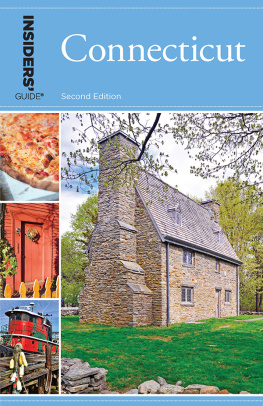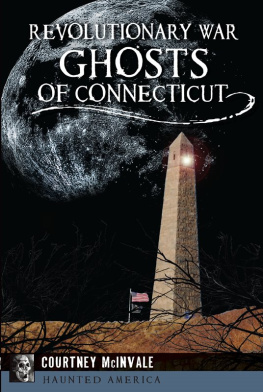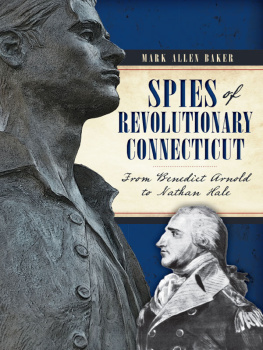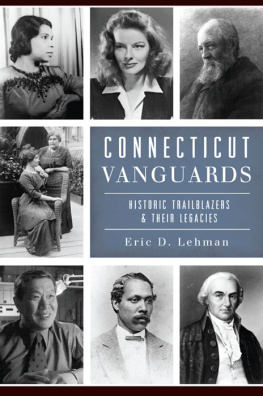N is for Nutmeg
A Connecticut Alphabet

Written by Elissa D. Grodin and Illustrated by Maureen K. Brookfield

To my parents.
ELISSA

In memory of my mother who rekindled my love for painting.
Thanks to Heather Hughes and Sleeping Bear Press for the opportunity
to grow creatively and explore new horizons. And to Barb and Jennifer
thank youits a pleasure to work with you both!
MAUREEN
A
During the 1940s there was a movement to adopt a state bird. Hearings were held at the state capital on the subject. Three requirements were established at these hearings for the qualities our state bird should have: 1. that it is frequently seen, especially by children, 2. that it have beautiful plumage, and 3. that it have a beautiful and easily recognizable song. The American Robin fit the bill perfectly and was adopted as the official state bird in 1943.
Robins eggs are so beautiful that a special color was named after them, robins egg blue. Artists like to paint their nests so they can incorporate this wonderful color. Next time you go to a museum, look for one in a still-life painting.
A is for American Robin, a lovely little fellow.
He sings a pretty tune, musical and mellow.

B
Phineas T. Barnum was born in 1810. Although we remember him as a circus promoter of Barnum & Bailey fame, during his lifetime Phineas was a leading citizen in his hometown of Bridgeport. As mayor he did many good things, such as creating city parks and bringing industry to Bridgeports economy so more people could have jobs.
His first sensation as a showman came when he was only twenty-five years old. Phineas featured Joice Heth, a woman claiming to be 161 years old and a former nurse for George Washington. (She was eighty.) Phineas had a success putting Joice on exhibit for people to see. Later in Barnums career, Queen Victoria of England became furious when he bought Jumbo the Elephant from the London Zoo. Jumbo became the circuss star attraction.
B is for Mister Barnum, and his animals and clowns.
He started a traveling circus for kids in all the towns.

C
In 1831 Prudence Crandall, a young Quaker woman in her twenties, was invited to head a girls school in Canterbury. She accepted, and the school was very successful.
When Sarah Harris, an African-American girl, applied, Miss Crandall admitted her, but the local citizens did not want Sarah there. They vandalized the school at night, throwing rocks and smashing windows. Angered at their bigotry, Miss Crandall decided to change school policy and made it for black girls only. Enraged, the townspeople were able to get a law passed that forced the school to close. Miss Crandall appealed the case in court and won, but vigilante violence forced the school to close for good. She moved out west in 1835 and continued her work as an educator. In 1886, near the end of her life, Miss Crandall was awarded a pension of $400 a year, as an apology from the state of Connecticut.
Because of her great courage, Prudence Crandall is Connecticuts state heroine.
C is for Miss Crandall.
When everyone said no!, she opened up a school for those who could not go.

D
In 1966 a man named Edward McCarthy, was operating a bulldozer, clearing land for a building site. He discovered something so amazing that it put a stop to the building ever getting built. He had stumbled upon hundreds of well-preserved dinosaur footprints from hundreds of millions of years ago, left during the Jurassic Period. Tracks from all sorts of dinosaurs are preserved at Dinosaur State Park in Rocky Hill. In fact, the Connecticut Valley has the most dinosaur tracks and footprints in the whole world.
A large, three-toed track of Eubrontes giganteus, our state fossil, can be seen at Dinosaur State Park. Thousands of Eubrontes tracks were found in a single layer of rock.
D is for Dinosaur State ParkThere are fossils all around, and hundreds of dinosaur footprints are buried in the ground.

E
Captain Adrian Block set out from Holland and sailed across the Atlantic Ocean with a fleet of four ships, The Little Fox, The Nightingale, The Tiger, and The Fortune. In 1613 the fleet arrived in New Amsterdam, now known as New York, and anchored there. While in the harbor, The Tiger caught fire and burned completely. Capt. Block built another ship, The Restless, which he sailed across Long Island Sound to Connecticut, leaving the rest of the fleet behind.
The wooded shoreline of our state looked invitingly green and lush. Capt. Block found the mouth of the Connecticut River and sailed up to explore. There he encountered Native American tribes. Eventually Capt. Block established a trading post, where Hartford is now. He traded tools and other goods with the Native Americans for furs, which were an extremely profitable item with the Europeans back home.
E is for Explorers who left their homes behind, and sailed across great oceans to see what they would find.

F
Our state was one of the original 13 colonies established by European settlers. In 1639 a new government was created by using a set of laws based on a democratic philosophy, saying that government should get its power from the free consent of the people. These laws were called the Fundamental Orders, and they were based on the writings of Reverend Thomas Hooker, a scholar and clergyman. They represent the first outline for a democratic government. Later, Thomas Jefferson would use these same ideas to construct the Declaration of Independence.
The state flag was adopted in 1897. Its motto, Qui Transtulit Sustinet is Latin for He who transplanted still sustains. It refers to the transplanted Europeans who thrived in their new land.
F is for the Flag, blowing in the breeze.
Made of silk, in blue and whiteA sight thats sure to please.

G
Did you know that there is a submarine capital of the world? Groton is home to The USS Nautilus, Connecticuts official state ship, which was the worlds first nuclear-powered submarine. Atomic (nuclear-powered) submarines can stay underwater for almost unlimited amounts of time. They have actually gone around the entire globe without surfacing.


















